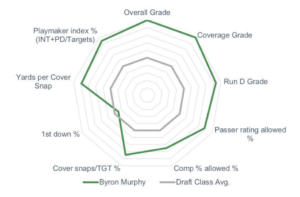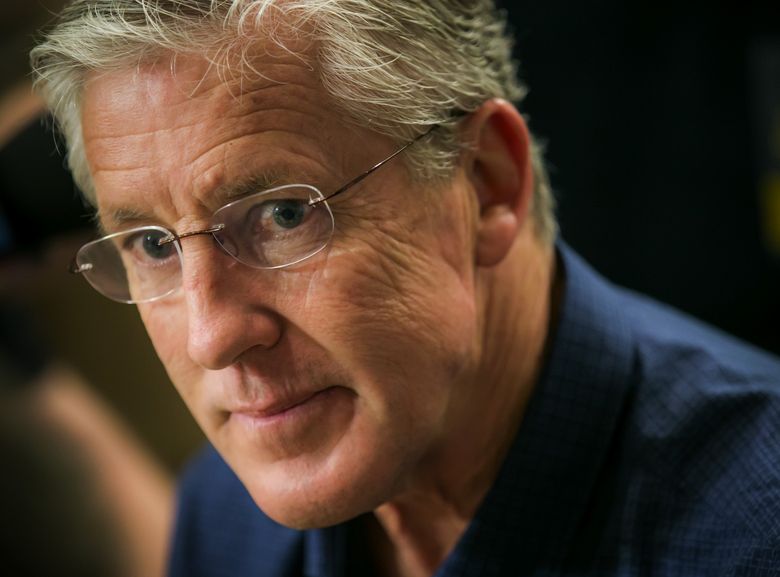
It’s a deep class at D-line, tight end, safety and receiver (such as Terry McLaurin)
I’ll keep updating this list before the draft. This is a first attempt having watched the players listed. There are some I still need to watch.
Legit first round (10)
Kyler Murray (QB, Oklahoma)
Quinnen Williams (DT, Alabama)
Nick Bosa (DE, Ohio State)
Rashan Gary (DE, Michigan)
T.J. Hockenson (TE, Iowa)
Devin White (LB, LSU)
Devin Bush (LB, Michigan)
Dexter Lawrence (DT, Clemson)
Ed Oliver (DT, Houston)
Montez Sweat (EDGE, Mississippi State)
I’ve felt for a long time that Kyler Murray is the most talented player in the draft and should be the #1 pick. Very little separates the top defensive prospects. Quinnen Williams and Nick Bosa are the best but the upside of the others is top level. I’ve added Devin Bush and Montez Sweat to this group following the combine. Traits matter in the NFL and both players tested well enough to warrant a first round grade.
Borderline first/second round (4)
Andre Dillard (T, Washington State)
Clelin Ferrell (DE, Clemson)
Christian Wilkins (DT, Clemson)
Josh Allen (EDGE, Kentucky)
All four of these players will go in the first round but I wanted some separation from the top tier. Andre Dillard is the best left tackle in the class. I marked Clelin Ferrell and Christian Wilkins down after the combine because neither tested as well as I expected. Josh Allen is a consensus top-five pick in the media but I still can’t shake seeing him handled by tight ends.
Injury flags — first round (2)
Jeffery Simmons (DT, Mississippi State)
Rodney Anderson (RB, Oklahoma)
Both Simmons and Anderson would be first round picks if it wasn’t for injuries. Simmons tore his ACL training for the combine and will miss the entire 2019 season. Anderson suffered a similar injury during the 2018 season. Neither player is expected to go in round one as a consequence but both possess first round talent.
First round analysis
Most people appear to be projecting between 10-15 legit first round prospects in this draft. Much will depend on how you view the quarterbacks. Some teams will have Drew Lock and Dwayne Haskins ranked very highly. The likes of the Clemson trio, Andre Dillard and Devin Bush will also receive fluctuating grades. This draft class provides quality depth at various positions but there’s not a strong pool of first round prospects. What does that mean? A lot of teams in the 20’s will want to move down and players drafted in the late first round will carry similar grades to the players drafted in the 40’s.
Second round (42)
Dru Samia (G, Oklahoma)
Chris Lindstrom (G, Boston College)
Kaleb McGary (T, Washington)
Jawaan Taylor (T, Florida)
Cody Ford (T, Oklahoma)
Garrett Bradbury (C, NC State)
Erik McCoy (C, Texas A&M)
Elgton Jenkins (C, Mississippi State)
Jonah Williams (C, Alabama)
Marquise Brown (WR, Oklahoma)
Parris Campbell (WR, Ohio State)
D.K. Metcalf (WR, Ole Miss)
Deebo Samuel (WR, South Carolina)
Terry McLaurin (WR, Ohio State)
Emmanuel Hall (WR, Missouri)
A.J. Brown (WR, Ole Miss)
N’Keal Harry (WR, Arizona State)
Drew Lock (QB, Missouri)
Dwayne Haskins (QB, Ohio State)
Will Grier (QB, West Virginia)
Noah Fant (TE, Iowa)
Irv Smith Jr (TE, Alabama)
Josh Oliver (TE, San Jose State)
Dawson Knox (TE, Ole Miss)
Kahale Warring (TE, San Diego State)
Josh Jacobs (RB, Alabama)
Jerry Tillery (DT, Notre Dame)
Trysten Hill (DT, UCF)
Dre’Mont Jones (DT, Ohio State)
L.J. Collier (DE, TCU)
Zach Allen (DE, Boston College)
Brian Burns (EDGE, Florida State)
Justin Layne (CB, Michigan State)
Greedy Williams (CB, LSU)
Byron Murphy (CB, Washington)
Taylor Rapp (S, Washington)
Amani Hooker (S, Iowa)
Marvell Tell III (S, USC)
Johnathan Abram (S, Mississippi State)
Darnell Savage (S, Maryland)
Marquise Blair (S, Utah)
Chauncey Gardner-Johnson (S, Florida)
There will likely be a run on receivers between picks #20 and #40. There’s a chance for the late first and early second round to be dominated by wide outs.
It’s possible none of the safeties will be taken in the first round. If that happens, things will pick up on day two. Many of the top safeties ran in the 4.3’s or 4.4’s. Teams will look at this group and see range and versatility. The ‘big nickel’ is a vital position these days and a lot of these safeties either played nickel full time in college or split their time.
The other position that could kick into gear is tight end. We could easily see Noah Fant, Irv Smith Jr and others (including Josh Oliver) go in the first frame. The earlier those three leave the board, the greater the chances of several other tight ends finding a home in round two. Dawson Knox could very easily be taken in this range and with many teams needing a tight end, some of the third round prospects could be pushed up a round.
There are a few names on the list I want to talk about briefly. Dru Samia the guard at Oklahoma is extremely physical and squares everything up. Watch his performance against Alabama. I think he’ll go a lot earlier than many are projecting. Utah’s Marquise Blair has the athleticism and quickness to excel at nickel and packs a punch as a tackler/hitter. He too might go a bit earlier than the consensus is predicting. Trysten Hill remains devastatingly underrated despite arguably the best combine workout at any position and Justin Layne could easily go in the first round (and could even be the first corner drafted).
Second round analysis
This is an excellent draft in rounds 2-3. Seattle’s challenge is to try and find a way to turn #21 into multiple day two selections. If they manage it, they’ll have plenty of options at several positions of need.
Third round (41)
Damien Harris (RB, Alabama)
Justice Hill (RB, Oklahoma State)
Miles Sanders (RB, Penn State)
Gary Jennings (WR, West Virginia)
J.J. Arcega-Whiteside (WR, Stanford)
Miles Boykin (WR, Notre Dame)
Hakeem Butler (WR, Iowa State)
Jace Sternberger (TE, Texas A&M)
Drew Sample (TE, Washington)
Trevon Wesco (TE, West Virginia)
Kaden Smith (TE, Stanford)
Greg Little (T, Ole Miss)
Isaiah Prince (T, Ohio State)
Bobby Evans (T, Oklahoma)
Dalton Risner (T, Kansas State)
Michael Jordan (G, Ohio State)
Connor McGovern (G, Penn State)
Daniel Jones (QB, Duke)
Christian Miller (EDGE, Alabama)
Jaylon Ferguson (EDGE, Louisiana Tech)
Jachai Polite (EDGE, Florida)
D’Andre Walker (EDGE, Georgia)
Chase Winovich (EDGE, Michigan)
Charles Omenihu (DE, Texas)
Joe Jackson (DE, Miami)
Anthony Nelson (DE, Iowa)
Renell Wren (DT, Arizona State)
Gerald Willis III (DT, Miami)
Ed Alexander (DT, LSU)
Khalen Saunders (DT, Western Illinois)
Mack Wilson (LB, Alabama)
Joejuan Williams (CB, Vanderbilt)
Michael Jackson (CB, Miami)
Trayvon Mullen (CB, Clemson)
Lonnie Johnson (CB, Kentucky)
Rock Ya-sin (CB, Temple)
Isaiah Johnson (CB, Houston)
Deandre Baker (CB, Georgia)
Deionte Thompson (S, Alabama)
Juan Thornhill (S, Virginia)
Nasir Adderley (S, Delaware)
Plenty of these names are borderline second round prospects. You could easily make a case for the receivers listed to go in round two. Miles Boykin had an exceptional combine, Hakeem Butler performed better than expected and J.J. Arcega-Whiteside boxes out defenders better than any receiver I’ve watched in college previously. Gary Jennings is underrated. They all have size.
The athletic potential of offensive linemen Chuma Edoga, Isaiah Prince, Michael Jordan and Connor McGovern could push them into round two on some boards. It’s also very possible Dalton Risner and Greg Little go earlier than I’m projecting here — it’s just a personal preference.
Jachai Polite I have falling due to a lack of size, length, speed (needs a good run at his pro-day) and some emerging character question marks. Mack Wilson is about as natural in coverage as you’ll ever see by a linebacker but a lack of great testing numbers and mediocre tape around the LOS has him lasting in this projection.
It wouldn’t be a surprise at all if Charles Omenihu, Gerald Willis and Ed Alexander carried second round grades by some teams. Many of the defensive backs listed could be graded a round earlier.
Third round analysis
As with the second round, this list really shows off the value you can expect in rounds two and three. The Seahawks will have plenty of options at receiver, D-line, tight end and safety/nickel after they inevitably trade down from #21.
Players not included
Riley Ridley (WR, Georgia) is a player I’ve found it very difficult to get excited about. His tape always felt underwhelming and his physical profile is average at best. I need to watch more of Tytus Howard (T, Alabama State). He received a lot of praise at the Senior Bowl despite that rep against Montez Sweat. I also want to watch more of Dax Raymond (TE, Utah State).
Max Scharping (T, Northern Illinois) is a player that some people see as a possible high pick but he didn’t stand out at the Senior Bowl. I really liked David Edwards’ (T, Wisconsin) 2017 tape but he didn’t test well and just doesn’t seem to have any momentum. Yodny Cajuste (T, West Virginia) failed to build his stock by not working out at the combine.
It was tempting to include Daniel Wise (DT, Kansas) in round three.
You can now support Seahawks Draft Blog via Patreon by clicking the tab below.
Become a Patron!





/cdn.vox-cdn.com/uploads/chorus_image/image/62866666/usa_today_11376222.0.jpg)


